 |

|
|
nRF T Click is an add-on board in the mikroBUS form factor. It features the Nordic nRF24L01P 2.4 GHz transceiver module with an embedded baseband protocol engine as well as 2.4 GHz PCB trace antenna. The board supports an air data rate of 250 Kbps, 1 Mbps and 2 Mbps and it is suitable for ultra low power designs. Typical applications include wireless PC peripherals, remotes, VoIP headsets, game controllers, sensors, home and commercial automation, active RFID, toys, etc. nRF C Click communicates with the target board microcontroller via mikroBUS SPI (SDI, SDO, SCK, CS#), CE and INT lines. The board is designed to use a 3.3V power supply only. |
|
|
|
 |
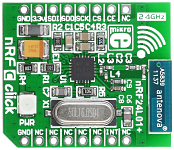
|
|
nRF C Click is an add-on board organised in the mikroBUS form factor. It features a Nordic nRF24L01P 2.4 GHz transceiver module with an embedded baseband protocol engine as well as 2.4 GHz SMD chip antenna. The board supports an air data rate of 250 Kbps, 1 Mbps and 2 Mbps and it is suitable for ultra low power designs. Typical applications include wireless PC peripherals, remotes, VoIP headsets, game controllers, sensors, home and commercial automation, active RFID, toys, etc. nRF C Click communicates with the target board microcontroller via mikroBUS SPI (SDI, SDO, SCK, CS#), CE and INT lines. The board is designed to use a 3.3V power supply only. |
|
|
|
 |

|
|
The nRF S click is a compact and easy solution for adding a 2.4 GHz transceiver to your design. It features a nRF24L01P 2.4 GHz transceiver module with an embedded baseband protocol engine as well as an SMA antenna connector (antenna sold separately). The board supports an air data rate of 250 Kbps, 1 Mbps and 2 Mbps and it is suitable for ultra low power designs. Typical applications include wireless PC peripherals, remotes, VoIP headsets, game controllers, sensors, home and commercial automation, active RFID, toys, etc. nRF S click communicates with target board microcontroller via mikroBUS SPI (SDI, SDO, SCK, CS#), CE and INT lines. The board is designed to use a 3.3V power supply only. |
|
|
|
 |
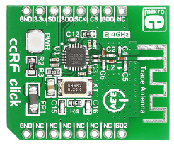
|
|
ccRF click is a low-power 2.4 GHz transceiver designed for the 2400- 2483.5 MHz ISM and SRD frequency bands. It features the CC2500 Low-Power 2.4 GHz RF transceiver as well as PCB trace antenna. The CC2500 is integrated with a highly configurable baseband modem that supports various modulation formats and has data rate up to 500 kBaud. Maximum device range is up to 20 meters in open space. ccRF click communicates with the target microcontroller via mikroBUS SPI, RST and PWM lines. The board is designed to use 3.3V power supply only. All these features make this board ideal for consumer electronics, wireless audio, wireless keyboard and mouse RF remote controls. |
|
|
|
 |
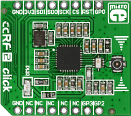
|
|
ccRF2 click carries CC1120, the fully integrated, high-performance single-chip radio transceiver with extremely low power consumption. Designed mainly for the ISM (Industrial, Scientific, and Medical) and SRD (Short Range Device) frequency bands at 164–192 MHz, 274–320 MHz, 410–480 MHz, and 820–960 MHz, CC1120 provides extensive hardware support for packet handling, data buffering, burst transmissions, clear channel assessment, link quality indication, and Wake-On-Radio. It also has exceptional receiver sensitivity. ccRF2 click communicates with the target board through mikroBUS SPI (MISO, MOSI, CSK), and AN, RST, CS, PWM and INT lines. The board is designed to use a 3.3V power supply. |
|
|
|
 |
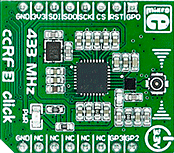
|
|
ccRF 3 click carries the CC1120 high-performance RF transceiver for narrowband systems from Texas Instruments. The clicks will enable you to add a low-power consumption radio transceiver at 433 MHz frequency. ccRF 3 click is designed to run on a 3.3V power supply. It communicates with the target microcontroller over SPI interface. |
|
|
|
 |
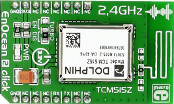
|
|
EnOcean 2 click carries the TCM 515Z transceiver, based on the 2.4 GHz IEEE 802.15.4 radio standard. The click is designed to run on a 3.3V power supply. It communicates with the target microcontroller over a UART interface. |
|
|
|
 |

|
|
EnOcean 3 Click carries a ultra-low power TCM515 transceiver gateway module which operates at 868MHz radio band, perfectly suited for the realization of transceiver gateways, actuators and controllers for systems communicating based on the EnOcean radio standard. For communication to other devices we have implemented PCB tray antenna on the board making this click ready to use device which can filter, decrypt and authenticate traffic before forwarding it to the processor or PC over UART.
EnOcean 3 click is supported by a mikroSDK compliant library, which includes functions that simplify software development. This Click board™ comes as a fully tested product, ready to be used on a system equipped with the mikroBUS™ socket.
Note: EnOcean 3 click is intended and certified to be used in Europe region.
|
|
|
|
 |

|
|
EnOcean 4 Click carries a ultra-low power TCM515U transceiver gateway module which operates at 902MHz radio band, perfectly suited for the realization of transceiver gateways, actuators and controllers for systems communicating based on the EnOcean radio standard. For communication to other devices we have implemented PCB antenna on the board making this click ready to use device which can filter, decrypt and authenticate traffic before forwarding it to the processor or PC over UART.
EnOcean 4 click is supported by a mikroSDK compliant library, which includes functions that simplify software development. This Click board™ comes as a fully tested product, ready to be used on a system equipped with the mikroBUS™ socket.
|
|
|
|
 |

|
|
6LoWPAN C click carries the CC2520 2.4GHz RF transceiver.
The click is designed to run on a 3.3V power supply. It communicates with the target microcontroller over SPI interface, with additional functionality provided by the following pins on the mikroBUS™ line: PWM, INT, RST, AN. |
|
|
|
 |
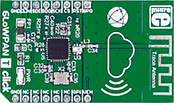
|
|
6LoWPAN T click carries the CC2520 2.4GHz RF transceiver.
The click is designed to run on a 3.3V power supply. It communicates with the target microcontroller over SPI interface, with additional functionality provided by the following pins on the mikroBUS™ line: PWM, INT, RST, AN. |
|
|
|
 |
|

